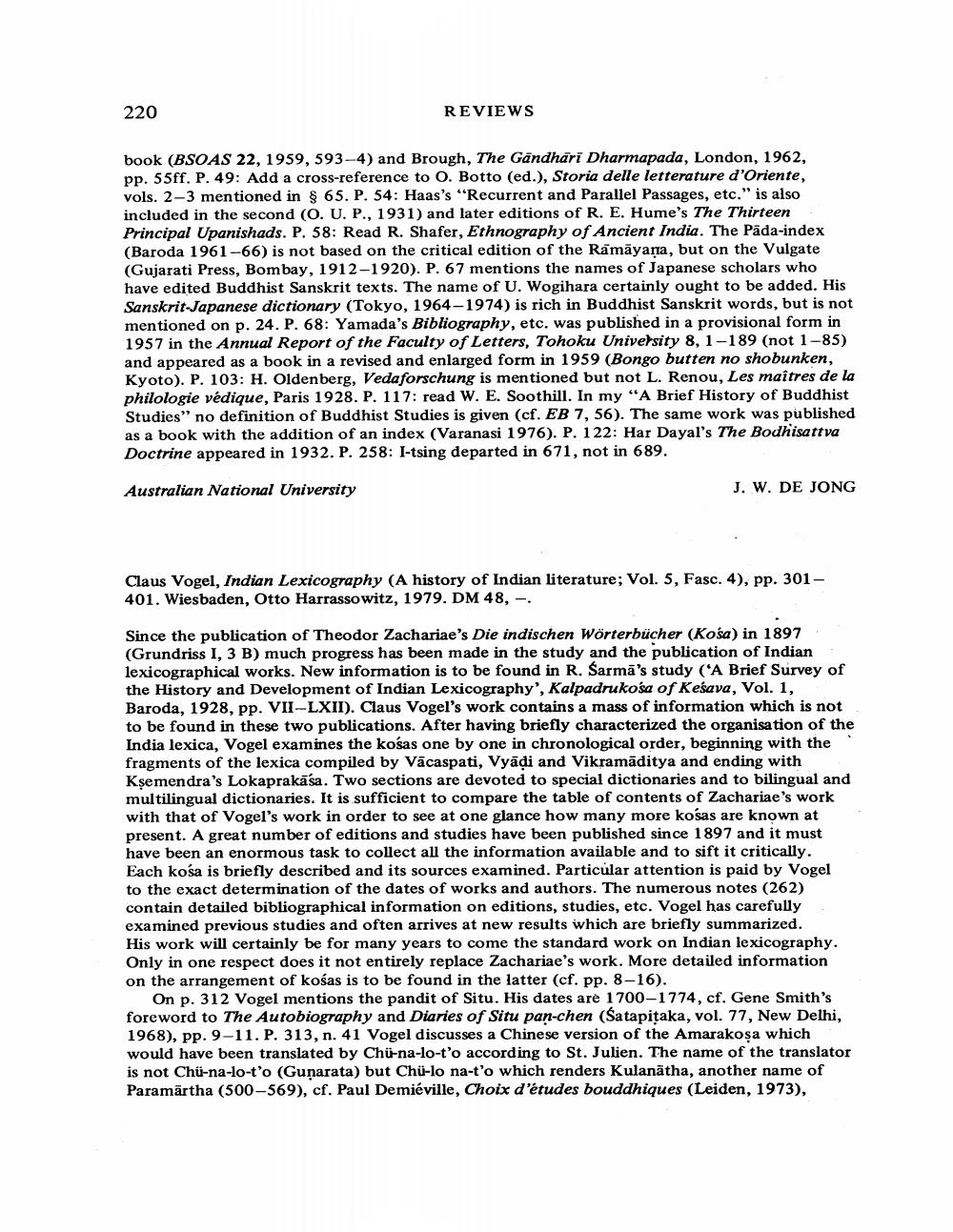Book Title: Book Reviews Author(s): J W De Jong Publisher: J W De Jong View full book textPage 2
________________ 220 REVIEWS book (BSOAS 22, 1959, 593-4) and Brough, The Gandhari Dharmapada, London, 1962, pp. 55ff. P. 49: Add a cross-reference to O. Botto (ed.), Storia delle letterature d'Oriente, vols. 2-3 mentioned in $ 65. P. 54: Haas's "Recurrent and Parallel Passages, etc." is also included in the second (O. U. P., 1931) and later editions of R. E. Hume's The Thirteen Principal Upanishads. P. 58: Read R. Shafer, Ethnography of Ancient India. The Päda-index (Baroda 1961-66) is not based on the critical edition of the Ramayaņa, but on the Vulgate (Gujarati Press, Bombay, 1912-1920). P. 67 mentions the names of Japanese scholars who have edited Buddhist Sanskrit texts. The name of U. Wogihara certainly ought to be added. His Sanskrit Japanese dictionary (Tokyo, 1964-1974) is rich in Buddhist Sanskrit words, but is not mentioned on p. 24. P. 68: Yamada's Bibliography, etc. was published in a provisional form in 1957 in the Annual Report of the Faculty of Letters, Tohoku University 8, 1-189 (not 1-85) and appeared as a book in a revised and enlarged form in 1959 (Bongo butten no shobunken, Kyoto). P. 103: H. Oldenberg, Vedaforschung is mentioned but not L. Renou, Les maîtres de la philologie védique, Paris 1928. P. 117: read W. E. Soothill. In my "A Brief History of Buddhist Studies" no definition of Buddhist Studies is given (cf. EB 7, 56). The same work was published as a book with the addition of an index (Varanasi 1976). P. 122: Har Dayal's The Bodhisattva Doctrine appeared in 1932. P. 258: I-tsing departed in 671, not in 689. Australian National University J. W. DE JONG Claus Vogel, Indian Lexicography (A history of Indian literature; Vol. 5, Fasc. 4), pp. 301 - 401. Wiesbaden, Otto Harrassowitz, 1979. DM 48, Since the publication of Theodor Zachariae's Die indischen Wörterbücher (Koša) in 1897. (Grundriss I, 3 B) much progress has been made in the study and the publication of Indian lexicographical works. New information is to be found in R. Sarmā's study (A Brief Survey of the History and Development of Indian Lexicography', Kalpadrukośa of Keśava, Vol. 1, Baroda, 1928, pp. VII-LXII). Claus Vogel's work contains a mass of information which is not to be found in these two publications. After having briefly characterized the organisation of the India lexica, Vogel examines the kośas one by one in chronological order, beginning with the fragments of the lexica compiled by Vācaspati, Vyāļi and Vikramāditya and ending with Ksemendra's Lokaprakasa. Two sections are devoted to special dictionaries and to bilingual and multilingual dictionaries. It is sufficient to compare the table of contents of Zachariae's work with that of Vogel's work in order to see at one glance how many more kośas are known at present. A great number of editions and studies have been published since 1897 and it must have been an enormous task to collect all the information available and to sift it critically. Each kośa is briefly described and its sources examined. Particular attention is paid by Vogel to the exact determination of the dates of works and authors. The numerous notes (262) contain detailed bibliographical information on editions, studies, etc. Vogel has carefully . examined previous studies and often arrives at new results which are briefly summarized. His work will certainly be for many years to come the standard work on Indian lexicography. Only in one respect does it not entirely replace Zachariae's work. More detailed information on the arrangement of kośas is to be found in the latter (cf. pp. 8-16). On p. 312 Vogel mentions the pandit of Situ. His dates are 1700-1774, cf. Gene Smith's foreword to The Autobiography and Diaries of Situ pan-chen (Satapitaka, vol. 77, New Delhi, 1968), pp. 9-11. P. 313, n. 41 Vogel discusses a Chinese version of the Amarakosa which would have been translated by Chü-na-lo-t'o according to St. Julien. The name of the translator is not Chü-na-lo-t'o (Gunarata) but Chü-lo na-t'o which renders Kulanātha, another name of Paramārtha (500-569), cf. Paul Demiéville, Choix d'études bouddhiques (Leiden, 1973),Page Navigation
1 2 3 4 5 6 7 8 9 10 11 12 13 14 15 16 17 18 19 20 21 22 ... 26
